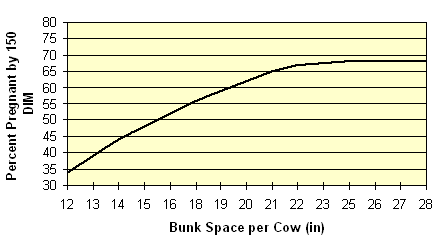



Know Your Feed Cost
Jim Paulson, Extension Educator at the University of Minnesota, Dairy Extension, asks which of the following factors affect reproductive performance of dairy cows: a) milk production, b) bunk space, c) type of bedding used in the far off pen, or d) hoof trimming schedule? Stay tuned — you might be surprised at the answers.Troubleshooting reproductive performance in dairy herds can be very frustrating. It often appears that herds very similar in management styles have very different reproductive performance. Some recent studies conducted by University of Wisconsin researchers may shed some light on why that might be. This is one of the most comprehensive studies ever conducted to determine the factors affecting reproductive performance in dairy herds. The 153-herd study used DHIA records, surveyed dairy managers regarding their management practices, evaluated body condition score on 63 of the farms, and obtained weather information from weather stations close to the farms. The researcher’s objective was to identify the factors that affect the first service conception rate or pregnancy status at 150 days in milk (DIM) on commercial dairy farms. Below are the some of their results.
First Service Conception Rate
Twenty-two factors were included in the model to determine what influenced first service conception rates. The average first service conception rate of the herds was 25.2%. Here are five major factors that had the biggest affect on first service conception rate:
- Bunk space: Herds with less than 2 feet of bunk space per cow in the breeding pens tended to have lower conception rates. Providing cows with two feet of bunk space per cow can be a challenge for some herds but it’s important. The study also found that herds with lower dry matter intake in the non-pregnant pens (i.e., fresh cow and breeding pens) had lower conception rates.
- Bedding type in far off dry cow pens: Herds that used sawdust bedding in far off dry cow pens had lower conception rates than herds that used any other kind of bedding. Sawdust bedding may result in an increase in metritis and/or mastitis, both of which have been shown to decrease reproductive performance.
- Milk production: Higher producing herds as well as higher producing cows within herds tended to have lower conception rates. This is really not anything new, as many other studies have also shown the same result.
- Hoof trimming policy: Herds in which cows received a maintenance trim less than once a year had lower conception rates. University of Minnesota research has shown that herds doing maintenance trimming less that once per year had a greater prevalence of lameness.
- Voluntary waiting period length: Herds with a voluntary waiting period of less than 41 days had lower conception rates.
Percent of Cows Pregnant at 150 Days in Milk
Overall, nearly 61% of the cows in this study were pregnant at 150 DIM. Researchers examined 25 factors that had an influence on this parameter. Some of the factors that affect conception rate also affect the percent of cows pregnant, but there were some differences.
- Bunk space: Bunk space per cow in the breeding pens again had an influence cows pregnant by 150 days. Figure 1 shows the predicted probability of a cow being pregnant by 150 DIM as bunk space increases. Other researchers have shown that cows consuming more dry matter in early lactation are more likely to become pregnant by 150 DIM. This may be more likely to affect cows that are more subordinate and less aggressive at the bunk.

Caraviello et al., JDS, 2006
- Body condition score: Body condition thresholds were 3.0 for animals from 60 days pre-calving to 30 days post partum, 2.5 for animals from 31 to 180 DIM and below 2.75 for cows greater than 180 DIM. This confirms several other previous research studies that show cows with low body condition have a more difficult time becoming pregnant.
- Milk production: Cows with low production or high production at the time of first insemination were less likely to be pregnant by 150 DIM (Figure 2). Cows that are lower producing at time of breeding may be cows that had health problems during the transition period or currently have clinical or sub-clinical disease. High producing cows tend to begin cycling later and usually have lower conception rates than lower producing cows.

Caraviello et al., JDS, 2006
- Heat observation: Even though most of these herds used synchronization programs to assist in getting cows pregnant, herds that watched for heat more often had a higher percentage of cows pregnant by 150 DIM.
I think this research points out a couple of interesting points. Reproductive performance is very complicated with many factors potentially affecting whether or not cows become pregnant. There are also many factors that we don’t often consider including transition cow management, periparturient diseases, early lactation body weight loss, and compliance with reproductive programs. But this study has shed light on some new factors as described above that may have some influence on reproductive performance of herds.
May 2008



